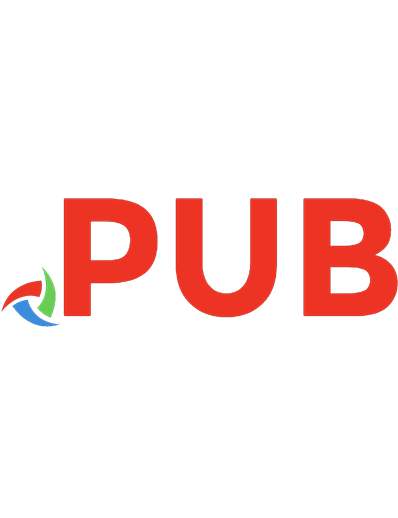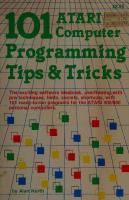101 Atari Computer Programming Tips & Tricks 0866680225, 9780866680226
101 Atari Computer Programming Tips & Tricks - Alan North - 1983 - ARCsoft Publishers.
110 34 4MB
English Pages 132 Year 1983
Polecaj historie
Citation preview
AN yy Compt
BOM comptes
[ee etnies
Pips tries
SWAaSe ie TORPEL EY LP |e i
ATARI 101 Computer
Programming Tips & Tricks
101 22"... ATARI
Programming Tips & Tricks by Alan North
ARCsoft Publishers
PRINT © PRINT PRINT "FOR & DIFFERENT" PRINT "SET OF NUMBERS," PRINT “PRESS RETURN® INPUT KS CLR &G OTO 18
Sample Run RUN
RE TURN
TYPESINGA SCORE 22 RE TURN ye RE TURN 28
77 ot 0
RETURN RETURN RETURN
LOW NUMBER IS 11 HIGH NUMBER IS 77
| 15
Keeping Game Scores
Writing a computer football game? Spelling bee? Cave adventure? No matter what kind of fun you are preparing, you’ll need a way to keep score. Here’s how. The wealthy English duke has just been killed in our little mystery game. In lines 10 through 160 of our program listing, below, you play the game, attempting to find out whodunit. The trick here is in the scorekeeping. Noteline170.If you guessed correctly in response to the queryinline160, at line170 the computer will give you credit by adding one point to your score stored in memory location R. It does that by comparing your line160 answer stored in P$ with the correct answer stored in A$. If you blew it and guessed wrong, the program drops below line170to line 180 where it increases your “wrong score” by adding one point to W. If you got a W+1atline 180, the program moves back toline100 and gets you to try again. If you scored a victory and got an R+1 atline170,the program jumps to line 200 where it stops to display your total right and wrong score. After that, it’s back to line 40 for a complete new runthrough.
Program Listing 1@ 20 3Q 4@ 50
PRINT "}"SREM CLEAR SCREEN DIM A$(7),PR#(7),08(7),D8(7) DIM E$(7),F$(7),G8(7),P8(7) S=INT(7*#¢(RND(1))) “IF veic THEN 40 29
60
FOR
7@
READ
L=1
OW
NEXT.
9@
RESTORE
TO
&
At
. "WHO
KILLED
1Q@
PRINT
11@
READ
120° {3@
RESTORE PRINT «PRINT
14@ 15@ 14@
PRINT PRINT PRINT
17@
IF
KEKE
"EEK
«PRINT
KERR
DUKE
THE
EREHEE”
7”
Bt, C#,D$,E%,F¢,6% "WAS
IT
THE..."
PB. Ct, D6,E%.F%,6% #PRINT "}"2REM BUZZER "“WHODUNIT "3: INPUT PS
At=P#
PRINT
THEN
“OR”
R=R+1:PRINT
YOU
ARE
KIGHT”®
ZPRINT "IT WAS THE "3A$=2GOTO 209 NOT THE "4P8!iW=W+1 "No! «PRINT PRINT SPRINT #GOTO 108 20@ PRINT ZIG@>PRINT "YOUR SCORE 1S... 22@ PRINT R53" RIGHT ",Wi "WRONG" 23@ PRINT sPRINT #GOTO 40 300 DATA BUTLER, NANNY, GARDNER, BURGLAR » SON, WIFE
18@
16
Batting Average
Once you know the number of times you were right and wrong ina game,as in Tip Number 15, it’s fun to convert those raw numbers to a batting average. Numbers right and numbers wrong take on a new meaning when changed to a batting average. Folks seem to be able to understand a batting average better. Our program, starting at line 900, is a partial listing designed to be tacked onto the end of your longer game program to display the final results of play. It will show the number of tries, number of right answers, percentage
right, and batting average. You'll want to test load this program so add lines 10 and 800 as shown. Line 800 will give you the R and T values you'll need going into the program at line 900.
30
Program Listing 1@ PRINT "}"iREM CLEAR SCREEN B@@ PRINT "NUMBER RIGHT: "3 81@ INPUT R g20 PRINT "NUMBER TRIES#: "s 830 INPUT T 780) PRINT Ri" RIGHT" Pi PRINT IN" sTser TRIES" 928 D=R/TIP=1@@*D:R=INT(C1@*P) S30 PRINT “THAT'S “3P3"- PERCENT" 949 PRINT "YOU ARE BATTING "$B
1f
Computer Rating Service
Of course, once you know a player’s batting average it still might need some interpretation. In this program, the computer takes a look at a batting average and makes a comment. Remember that this listing, starting here with line 800, is a partial program to be tacked on the end of a longer game. Note that, at 800, you already have values for G (number right) and E (number of tries). Line 810 converts those raw numbers to a batting average (H).
Program Listing SU 9PRIY "2" REM CLEAR SCREEN 7@@ PRINT "NUMBER RIGHT: "5 7iQ@ INPUT G P20 PRINT "NUMBER OF THIES! 4 Pam INPUT -E BOO PRINT Gs” RIGHT IN *"S5E5" TRIES? 81@ H=INT((G/E)*18@Q) B2@ PRINT "YOU ARE BATTING "5 830 PRINT "YOU ARE "5 84@ IF H“1@@ THEN GOTO 971@ B5@ IF Hi3@@ THEN GOTO 920 846@ IF H*5@@ THEN GOTO 930 31
a7eh BEE) ORG 918 928 938 94@ 9 958 976
IF He7@@ THEM GOTO 948 IF Hi9@@ THEN GOTO 95a PRINT "HALL OFS FAME" 'GoTO 948 PRINT. "THE PI TS2*@urorrag PRINT "POOR" *GOTO 946@ PRINT "AVERAGE" !GOTO 96@ PRINT "TOP NOTCH" ?GOTO 948 PRINT "DAMN NEAR PERFECT!” PRINT "YOUR BATTING AVERAGE IS END
18
"3H
Box Score
To dress up scores during and at the end of a game program, use this method of putting those scores in a box. The box around the score will highlight it and jazz up your video display.
Program Listing 1@ 2@ 3G 44 5@ 6 7@ Be 98 126 11@ 128 13) 14 15@ 144 17@ 18@) 19@
32
PRINT "3"2REM CLEAR SCREEN DIM N€t2O),5#¢8) PRINT "PLAYER*’S NAME: "5 INPUT Nd ‘ PRINT. “PLAYERS SCORE: °% INPUT & PRINT S$=STR#E(S) LN=LENCN$) +LEN (S$) LT=LN+1 4 FOR b=) TOM PUT Ting edea8 NEXT L PRINT PRINT "* "SN#§""S SCORES "sSgs" FOR L=1 TO LT PRIWTug eet NEXT LL PRINT =PRINT #GoTo 3a
x"
Sample Run EME RHEE EH REE KEE EEE HE ® EDWARD*™S SCORE: 1234 # HR HEKKEEEEKEEEKRHEE EEE EEE E
33
nate!
hPa
HO, Tg
= 4
o mitt Gore Vai
"
:
’
»
46
dren
Ae
|
A-
aa
a,
it Rios
eal| i ont
rt
;
«hbase ,
Ht
a
i
te a
:
ot
4
ae
_
=
~¥]
a
Score
ae
;
e
7
aed
a
wis
eee
hea rah ‘So 0 ¢
ye
me iy
: -
%
fisid
’
a a he sacha 4@ See ah 8 ave Petey geste, 7 eeethng! jae oe
Me
“’
7
,
*
ea
ws,
e ;
"so
a
ae
me
a7
oi
:
7.7
:
=
SS
;
rg fetag
renee
or
po
'
oP
>»
¥
.
Aa
Text On Text
19
Create a Quiz
One of the most fascinating uses for your Atari is in having it carry on a video conversation with your friends, relatives and neighbors. One useful way to promote such conversation is through a quiz. An instruc: tional, educational quiz, such as we have here. Quiz data—the computer’s storehouse of knowledge—is in lines 20 to 70. Be careful, when you type
them into your, Atari, to include the commas separating the two halfs of each data line. Spelling and spacing must be exact. Lines 90 and 100 obtain a random number in the range of 1 to 11. Line 110 selects the data line for a question. Lines 120 through 140 get the appropriate word FIRST, SECOND, THIRD, FOURTH, FIFTH or SIXTH from the selected data line. Lines 160 to 180 print the quiz question on the screen, while line 190 reads the DATA line to learn the correct answer. You provide your response when the computer asks for it at line 200. Lines 220-240 decide whether you are right or wrong. Of course, the quiz can be made much longer. In this example, it could be expanded to encompass all past U.S. presidents.
Program Listing {1@ 15 24 3@ 40 3 6@ 7@ B@ BS 9@ 10@ 110
36
PRINT "}"2REM CLEAR SCREEN DIM S#(9).C8(20),D8¢(20) DATA FIRST, GEORGE WASHINGTON DATA SECOND, JOHN ADAMS DATA THIRD, THOMAS JEFFERSON DATA FOURTH, JAMES MADISON DATA FIFTH, JAMES MONROE DATA SIXTH, JOHN QUINCY ADAMS PRINT "HOW MANY U.S. PRESIDENTS" PRINT "CAN YOU NAME" R=INTC12*(RND(1))) IF R*«1i THEN 9@ IF INT(R/2)=R/2 THEN R=R+1
i2@ 13G@ 14@ i15@ i16@ i7@ le@ iv@ 2@@ 21@ see 230 248 2a 254 2( 230
FOR L=1 TO R READ & NEXT-L PRINT =PRINT PRINT "WHO WAS THE" PRINT S# PRINT “PRESIDENT GF THE U.S." READ C# INPUT Ds PRINT IP DS=Ct THEN PRINT “THAL2S CORRECT PGOTO S40 PRINT "THAT*S WRONG" PRINT “THE "$845" PRESIDENT WAS " PRINT Cs RESTORE BIPRIMD ePRINT GOTO 70
20
Killing Time
Sometimes, it may seem to you as if the computer will never get to the result of a job. You understand the processing delay but your non-computer friends may not. They could be confused by the wait and think the computer is “broken.” To keep their minds off the slowness, give them something to look at while the computer is “thinking.” The added, extra lines, numbered 50, 60, 70 and 80, take up more processing time but make for less confusion. Computing may take a bit longer but your fun will be increased. If you delete lines 50-80 you’ll see how the program runs faster but the blank screen is confusing.
Program Listing 1@ 2@
PRINT PRINT
"}"2REM SCREEN CLEAR “GIVE ME A NUMBER "a: INPUT
N 37
"
30 4@ Sa 4@ 7@ 8@ 9@ 1@@ 11@ 12@ 13@ 223@ 21@
FOR L=i TO WN X=xX+L FOR T=1 TO 1@@°NEXT T CLEAR PRINT "“}"RREM SCREEN FOR T=1 TO 1@@:NEXT T "IT AM THINKING" PRINT NEXT L. CLEAR "}":REM SCREEN PRINT "I HAVE THE ANSWER”: PRINT PRINT “THE TOTAL OF ALL NUMBERS" PRINT IS "5% 1 TO "SN5" "FROM PRINT PRINT :PRINT =#PRINT CLR :GOTO 2@
21
Word-Error Trapping
The same kind of error trapping is available for strings. Suppose the program, as in this example, asks at line 10 for a word. It is looking for YES or NO. If it gets a YES,
then
line 20 sees
that
it got what
it wanted
and
moves operations along to line 100. If it gets a NO, then line 20 hasn’t received what it wants so program execution moves on to line 30. Here, at line 30, the program finds something useful and shoots operations down to line 200. If, however, neither YES nor NO were entered at line 10, then neither lines 20 nor 30 would be satisfied so action would drop to line 40. Here, the error is trapped by commanding the operator to give one of the two correct answers. Then, at line 50, the operation is returned to line 10 for a new try at the correct input.
Program Listing 3 DIM A$(3)EPRINT "}"SREM CLEAR SCREEN 1@ PRINT "WANT TO PLAY AGAIN "FiINPUT At 20 IF At="YES" THEN 10@ THEN 2a@ 30 IF At="NO" 4@ PRINT "PLEASE ANSWER ONLY YES OR NO”
59@ PRINT :GoTO 1@ 1@0 PRINT "THANK 11@ PRINT = PRINT 28@ PRINT "THANK 214 PRINT =*PRINT
22
YOU FOR THAT #GoTO 18 YOU FOR THAT Which is Largest? Suppose you have a group of numbers and you would like to know which number is largest within the group?
71
Here’s a software routine for your Atari so it can locate the largest number. You can key in as many numbers as you wish. To end that entry cycle, type in a zero. The computer will see that zero as its cue to leave the entering routine and get on with computing. Line 40 tests each new number as you enter it. If a new number is larger, that new number is stored in memory location D. At the end of the entry cycle, the largest number is left stored in D. Line 70 recalls that largest number and prints it.
Program Listing 1@ 20 3@ 4@ 5@ 6@ 70 B@ SW
PRINT "}":REM CLEAR SCREEN PRINT "GIVE ME A NUMBER",: INPUT Z IF Zg=@ THEN 4@ IF Z:D THEN D=2 GOTO 20 PRINT «PRINT PRINT "THE LARGEST NUMBER Ia FG PRINT © PRINT #¢PRINT = PRINT COR 26070 =e
54
Reciprocals
Key in any number. The computer will display its reciprocal. The actual conversion is done here at line 30.
Program Listing 10 PRINT °}* SREM* SCREEN" GLEAR 15 PRINT "NUMBER TO BE CONVERTED" 2WoRFRINT “TO TTS REC LRPRUCAL Ss fs Zo .hPUT OM 3@ R=1/N So PRIM PRINT 40 PRINT "RECIPROCAL OF "SN3" IS 45 PRINT =PRINT SM CLR smOTO 15
"§R
55
Dump the Integer
Look at the number 123.456 with an eye toward how to get rid of the portion left of the decimal point. Keep only .456 and dump 123. Here’s a short program tc accomplish that. Try 5.67. It will come out .67. Or 500.5 which wil! come out .5.
Program Listing LA 2@ 3@ 4@ 3@ 6@ 7@ So 90 1@@
PRI Wo ie REM SCREEN. CLEAR PRINT "GIVE ME A NUMBER" PRINT "WITH A DECIMAL=:" INPUT WN X=N~-INTCN) PRINT PRINT "THE FRACTIONAL PORTION" PRINT “OF YP She IS 8 Ex PRINT = PRINT =«PRINT #=PRINT CLR #GOTO 2a
56
Averages
Key in numbers in any order. A zero will end entry. The computer will tell you the average number of all numbers you entered. Line 40 finds the total number of all numbers entered. Line 50 finds the total of entered numbers. Line 70 computes the average.
Program Listing 1Q@ 2@ 30 40
PRINT "}"2REM CLEAR SCREEN PRINT "GIVE ME A NUMBER", = INPUT IF Z=@ THEN 70 N=N+1
Z
73
5@ T=T+2Z 6@ GOTO 2 7@ A=T/N {2G} PRINT = PRINT 11@ PRINT "THE AVERAGE IS "GA 12@ PRINT @#PRINT PRINT & PRINT 130 CLR 'GOTO 2a
5/
Mid-Range Number
Here’s how to find the middle of a range of numbers. You key in as many numbers in a series as you wish. After the last number, key in a zero to move the program out of the entry cycle. Lines 40 to 70 select the highest and lowest numbers in the range. They actually define the range. Then line 90
finds the middle point of that range. Program Listing
12 2@ 420 4Q@ 5@ 6@ 7@ 8G 9@ i@@ 11@ 120 13@
PRINT "}":PEM SCREEN CLEAR PRINT "GIVE ME A NUMBER".:INPUT IF %=@ THEN 9@ N=N+4 IF N=i THEN H=Z!:L=Z IF ZH THEN H=Z GOTO 2a M=L+((H~L)/2) PRINT =#PRINT PRINT "MID-RANGE NUMBER:",M PRINT =PRINT ! PRINT : PRINT CLR
'GOTO
58 The technique 74
Z
2a
Rounding Off for rounding
off numbers
is easy.
This program, which can stand alone or be worked into a larger program as a Subroutine, rounds a decimal to the
nearest whole number. There are two views on how to round off. One holds that “if the number is more than five, you round up.” Which means that exactly 0.5 rounds down. Another view is that “any number less than five rounds down.” In that case exactly 0.5 rounds up. The first set of program lines below is for the fellow with the ‘‘more than five rounds up” idea.
Program Listing 10 2@ oO 4@ 5@ 6@ 7@ 8@ 96 102 11@ 12@ 150 14@ 15@ 160
PRINT "}":REM SCREEN CLEAR PRINT "GIVE ME A NUMBER” PRINT “TO BE (ROUNDED OFF" INPUT WN IF NeInTiN) THEN 8@ R= GOTO 12308 D=N-INT CN) IF [email protected] THEN 1206 R=INTCN) GoTo 13@ R=INTCN)+1 PRINT °F" 2.REMMEUZZER PRINT Na" ROUNDS OFF TO "GR PRINT =PRINT =PRINT CLR :GOTO 20
The second set of program lines rounds off on the “less than five rounds down”’ theory.
Program Listing 12 20 3@ 4Q 5Q@ 46@ 70
PRINT *7°2REM SCREEN. CLEAR PRINT "GIVE ME A NUMBER" PRINT "TO BE ROUNDED OFF" INPUT N IF NeINT(N) THEN 8@ R=N GOTO 130 75
8@ 92 1@@ 11@ L2@ 13@ 14@ 15@ 16@
D=N-INT CN) IF D et Mmm
Sample Run PROFITS 1978 1979
1=n =:
19°30: 193) 1938
1 01
Background Cycler
Need a fast way to review the various background colors available on the graphics screen? This program uses graphics mode 10 and cycles thtough the many background colors. The appropriate background color is POKE’d into
memory location 704 at line 1020. The FOR/NEXT loop in lines 1010 to 1040 causes the cycling through the background-color numbers. Line 1030 is a time-delay loop, placed there to allow you to study each color briefly before it is replaced by a new color. To add more delay, increase the number 100 in line 1030. To speed things up, decrease the number 100 in line 1030.
Program Listing 1@0W@ IOI {1920 1@3@ 1840 10358
GRAPHICS 108 FOR Leia fT). 253 STEP 16 POKE 7@4,L. FOR T=1 TO 10@:NEXT T NEAT L GOTO 1010 ae
*, +
'
= ree
re
e
‘
anion acca
pre ‘ eS eaceaneamgenersmmatie ARSE
mis
=
. :
et
t
||
teeter
‘(24
’
_
.
_
oer
ee
a
rr
Pi
‘nai Ty
yh wi
dys
F
“al
os at ivete .
Pine
+1
whe
a
se
_
.
gu?
;
'igswe
Pa
°
: 544
a
Peer :
"
+a
SE*
>
oy: é\4
"4e"46
PROF 7
—°
7
a.
i
—
“
‘Thr
51
Oh
at,
o FF oS
=
— tee
ea
ren
tee Lez,
sal
ware
;
23a
: a
P 20xebavarptcasyy U F :
6 eence wall teeth ¢ % ocr wol
‘eden
Oh
Ot mo-2sideband
are ant htt sithcag -
ati
a
; —_
——.
vir
fis > nat
HO 'A
6 me
:
Gham
oa ages: es'ay2 pea Of
(nea
* an
*; preondi
ne
AAS stehawage
a OX
poaagel yA
ee pean zap ni eal demgrsbe enh rey ‘i édtingeren tegrep et eA 4fr, 1 pei eel. Qon! yaind sent = erGbOr sald
uebditph bseORR Yelgo fame ene
i
Wed has} arson! else
# ns
baat aDap
RRC
308):
os is
a
Bb
his
S874 ¢-
~s
7
te Abe Sey
iRe-agte tt ae le a Mar
id in 5
7we
ut 5
Oa
a
6
NE
=
. ri
Appendix
x *
Appendix A: ATARI BASIC Words Here is a handy list of all the words in the ATARI version of the BASIC computer language: ABS ADR AND ASC ATN BYE CLOAD CHR$
absolute value function string memory address function logical expression true only if both are finds ASCII character number arctangent leave BASIC; write directly on screen load program from tape converts ASCII number to character
CLOG CLOSE CLR COLOR COM
base 10 logarithm close file at end of I/O job undimensions strings and arrays select color register for graphics same as DIM continue, after BREAK or STOP cosine sends data from computer to tape stores info in program line
CONT COS CSAVE DATA
121
DEG DIM DOS DRAWTO END ENTER EXP FOR FRE GET GOSUB GOTO GRAPHICS
switch to trig degrees from radians reserves memory for array or string displays disk menu draws line between points concludes a program run input data or programs e to a power sets range of FOR/NEXT loop shows remaining available memory input single byte of data, with disk branch to subroutine branch to a line selects graphics mode decision maker stops for keyboard input of data portion of number left of decimal number of characters in a string optional; assigns value to variable display contents of program memory send program from disk to computer stores specific graphics point natural logarithm print on paper with line printer erase all program and data memory other half of FOR/NEXT loop not true =1; true
=0
used with disk use with GOTO or GOSUB opens a file for I/O
branches
if either true, a 1; 0 if both false position of game paddle look in one memory location light a single dot on video screen for disk operations put info.in one memory location abnormal departure from GOSUB loop move to specific video screen point Causes output from the computer Status of trigger button on paddle Output one data byte from computer trig info in rads, not degrees get info from DATA lines
REM RESTORE RETURN RND RUN SAVE SETCOLOR
ignore these remarks allows DATA lines to be re-read back from subroutine to main program random number between 0 and 1 execute a program store data or program on disk store color data find sign of a number sine control pitch, volume, tone square root asks state of I/O device size of skip in FOR/NEXT loop position of stick game controller determines if stick trigger button is pressed temporary program run halt changes number to character string IF true, does what follows part of FOR/NEXT loop range on input error, jumps to a line machine-language subroutine converts string to a number 1/O in graphics or disk work
123
Appendix B: Error Messages These are the messages your ATARI is trying to send you when it presents an error number. Naturally, it tells you the line number where the error is located. Number
2 3 . 4
124
Message you have used up all available memory the number can’t have the value it has you are only allowed 128 different variable names your string is longer than the space you dimensioned . you are tryng to READ more DATA than you have available a number is greater than 32767 you are trying to put string data in a number variable you have not dimensioned an array or string properly
10 17
12
13 14 15 616 17
18 19 20 21 128 129 130 131
132 133 134 135 136 137
138 139 140
you simply have too many GOSUBs you either have tried to divide by zero or else you want a result too large or too small for the computer to handle you are using GOSUB or GOTO or THEN to jump to a nonexistent line number you have a NEXT but there was no FOR the statement simply is too long or too complex for BASIC to handle again you have tried a NEXT or a RETURN without the necessary FOR or GOSUB there is a RETURN without a GOSUB don’t POKE there; try NEW to get out of this mess; if that doesn’t work, kill the power and turn it back on and re-enter the program without POKEs you are trying to use an invalid string character there’s not enough memory to complete the LOAD you have a device number larger than 7 or equal to zero you are trying to LOAD a no-LOAD file you hit the BREAK key while the machine was doing something the input/output control block already is open you are calling for a nonexistent device you have sent a read command to a writeonly device, the printer you can’t use that command for that device you forgot to open the file or device that is an illegal device number you are trying to send a write command toa read-only device you have read to the end of the file you are trying to read a record longer than 256 characters the device is turned off, dummy you are getting garbage at a serial port or else you have a bad disk drive input framing error
125
141 142 143 144 145 147
126
your cursor is out of range for that mode serial bus data frame overrun . serial bus data frame checksum error you are trying to write on a write-protected disk something’s wrong with what you just wrote that function is not implemented you don’t have enough memory available for the graphics mode you selected that’s a drive number error you have too many files OPENed the disk is full you’ve blown the whole bit file numbers don’t match, the disk links are messed up that’s a file name error there’s an error in the POINT data length that file is locked that command is invalid the directory is full that file cannot be located anywhere the POINT is invalid
books from ARCsoft Publishers For the TRS-80 PC-1, PC-2, Sharp PC-1211, PC-1500: 99 Tips & Tricks for the New Pocket Computers
128 pages
(PC-2/PC- 1500)
$7.95 101 Pocket Computer Programming Tips & Tricks 128 pages $7.95 Pocket Computer Programming Made Easy 128 pages $8.95
ISBN 0-86668-019-5 ISBN 0-86668-004-7 ISBN 0-86668-009-8
Murcer In The Mansion and Other Computer Adventures
96 pages
$6.95
ISBN-0-86668-501-4
50 Programs in BASIC for Home, School & Office
96 pages
50 MORE 96 pages
$9.95
ISBN 0-86668-502-2
Programs in BASIC for Home, School & Office $9.95 ISBN 0-86668-003-9
35 Practical Programs for the Casio Pocket Computer
96 pages
$8.95 ISBN 0-86668-014-4 Pocket-BASIC Coding Form programming worksheet tablets
40-sheet pad
$2.95
ISBN 0-86668-801-3
For the TRS-80 Color Computer:
101 Color Computer Programming Tips & Tricks 128 pages $7.95 ISBN 0-86668-007-1 55 Color Computer Programs for Home, School & Office 128 pages $9.95 ISBN 0-86668-005-5 55 MORE Color Computer Programs for Home, School & Office 112 pages $9.95 ISBN 0-86668-008-X Color Computer Graphics 128 pages $9.95 ISBN 0-86668-012-8 The Color Computer Songbook 96 pages $7.95 ISBN 0-86668-01 1-X My Buttons Are Blue and Other Love Poems
96 pages
$4.95
:
ISBN 0-86668-013-6
Color Computer BASIC Coding Form program worksheet tablets
40-sheet pad
$2.95
ISBN 0-86668-802-1
For the APPLE Computer: 101 APPLE Computer Programming Tips & Tricks 128 pages $8.95 33 New APPLE
ISBN 0-86668-015-2
Computer Programs for Home, School & Office
96 pages $8.95 ISBN 0-86668-016-0 APPLE Computer BASIC Coding Form program worksheet tablets 40-sheet pad $2.95 ISBN 0-86668-803-X For the ATARI 400 and 800 computers: 101 ATARI
Computer Programming Tips & Tricks 128 pages $8.95 ISBN 0-86668-022-5 31 New ATARI Computer Programs for Home, School & Office 96 pages $8.95 ISBN 0-86668-018-7 ATARI Computer BASIC Coding Form program worksheet tablets 40-sheet pad $2.95 ISBN 0-86668-806-4
127
‘books from ARCsoft Publishers For the Sinclair ZX-81 and TIMEX/Sinclair 1000 computers: 101 TIMEX
1000 and Sinclair ZX-81
128 pages
“N
Programming
$7.95
37 TIMEX 1000 & Sinclair ZX-81
Tips & Tricks
ISBN 0-86668-020-9
Programs for Home, School & Office
96 pages $8.95 ISBN 0-86668-021-7 TIMEX 1000 & Sinclair ZX-81 BASIC Coding Form program worksheets 40-sheet pad $2.95 ISBN 0-86668-807-2 For the electronics hobbyist: 25 Quick-N-Easy Electronics Projects
96 pages $4.95 25 Electronics Projects for Beginners 96 pages $4.95 25 Easy-To-Build One-Night & Weekend
96 pages
ISBN 0-86668-023-3 ISBN 0-86668-017-9 Electronics Projects
$4.95
ISBN 0-86668-010-1
Computer program-writing worksheets: Each in tablet of 40 sheets with stiff backing
Universal BASIC Coding Form IBM Personal Computer BASIC Coding Form ATARI Computer BASIC Coding Form
$2.95 $2.95 $2.95
Pocket Computer BASIC Coding Form APPLE Computer BASIC Coding Form Color Computer BASIC Coding Form
$2.95 $2.95 $2.95
TIMEX 1000/Sinclair ZX-81
$2.95
ISBN:
BASIC Form
International Standard
Book
Number
ARCsoft Publishers Post Office Box 132 Woodsboro, Maryland 21798
128
ATARI Computer Book II
101 ATARI Computer Programming Tips & Tricks
Onlc Bi a D i
eby Alan North
Here’s a giant collection of practical, useful, efficient program- : ming techniques and operating shortcuts, for the ATARI model 400, — 600 and 800 personal computers, right out of a master programmer’s | notebook.
Loaded with hints, secrets, tips, tricks and easy-to-follow instruc- — tions, this book shows you how to handle routine programming chores ~ on the Atari more quickly, do special effects, make your computer ~ work for you—faster and more efficiently. Each of the 101 computer programming tips in this book features a complete ready-to-run program. Each will run immediately, aS you find it in this book, or it easily can be included in a larger set of instructions to your computer. All 101 programs have been tested thoroughly — on the ATARI 400/800 Computer and are ready to type in and run. Learn insider's how-to secrets for using the special, exciting — BASIC words READ, DATA, RESTORE, INPUT, LEN, GOSUB, RETURN, ~ VAL, ASC, CHR$, PRINT, DIM, FOR, NEXT, IF, THEN, DRAWTO, SET- — COLOR, and many more. Sections in this book include a detailed /ntroduction; Fun and — Games; Text on Text; Gee Whiz; Number Crunching; Money Matters; — Colorful Graphics; and a handy Appendix. You will find special techniques for graphics; colorful program ‘ titles and billboards; coin toss; dice throw; secret message; bell — ringer; mystery clues; code groups; 60-second timer; sorting; ordering; © searching; averaging; passwords; sentence writer; creating tables; memory tester; exam sorter; rounding off; random numbers; shopper’s friend; interest on money; car payments; wages 7 hours; percentage off and mark up; invoicing; inventory counter; lists; two dozen exciting ia
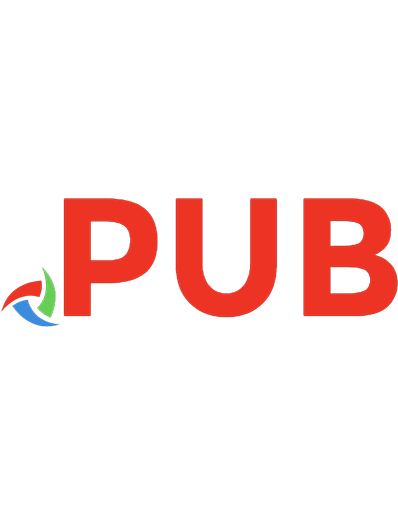

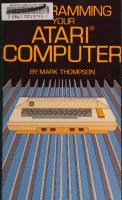

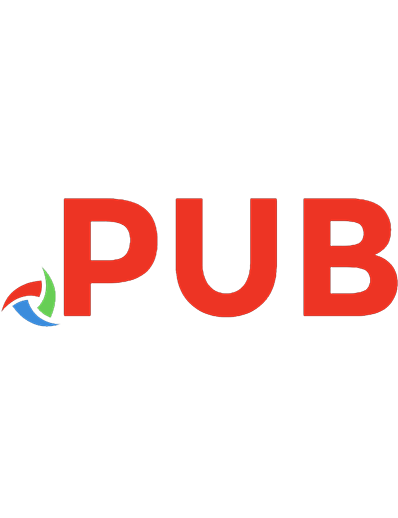
![Vectorworks - 101+ Tips and Tricks [2 ed.]](https://dokumen.pub/img/200x200/vectorworks-101-tips-and-tricks-2nbsped.jpg)
![The Photoshop anthology: 101 web design tips, tricks & techniques [1st ed]
0975841920, 9780975841921](https://dokumen.pub/img/200x200/the-photoshop-anthology-101-web-design-tips-tricks-amp-techniques-1st-ed-0975841920-9780975841921.jpg)

